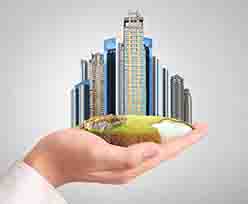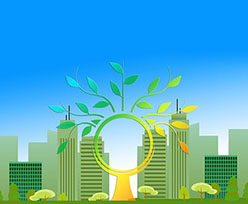Blog
How building India’s urban cities can help in achieving UN SDGs
Background
In 2015, the 193 UN member states adopted the new Sustainable Development Goals (SDGs) comprising 17 goals, 169 targets and 100 global indicators.
Earlier on, between 2000 and 2015, the Millennium Development Goals (MDGs) provided an important development framework and achieved success in areas such as poverty reduction, and health and education in developing countries. The key difference is that the SDGs amount to an inclusive framework for broader adoption built on the success of the MDGs. They span emerging focus areas relevant to a new world order - new areas of climate change and disaster risk; economic inequality; peace and justice; and sustainable consumption and innovation.
It’s a framework for all: the corporate sector, governments and individuals all have a role to play. Also, it does not differentiate between developed and developing nations. The SDGs help define the ‘sustainability context’ of all our anthropogenic activities, identify risks and opportunities, and define a roadmap for action towards a sustainable world for all. The framework covers climate change action and enables a circular economy: the two biggest opportunities of current times.
The SDGs succeed the MDGs in providing a global framework leading to a sustainable world by 2030.
The case for a sustainable built environment
By 2030 cities are likely to house 40% of India’s population . Building cities is capital intensive and requires long-term planning. However, how we build our cities is what will define how India can achieve its SDGs. The how must incorporate resilience to mitigate climate risk and productivity loss; ensure inclusivity; and be biodiverse and socially vibrant. This is the vision for India.
Buildings in India account for 40% energy use, 30% raw material use, 20% water use and 20% land use; they also generate 30% of solid waste and 20% of water effluents. The real estate sector is responsible for 24% of India’s annual CO2 emissions , contributing to global warming and poor air quality. Is India ready to mitigate the environmental fallout of its real estate sector?
The good news is that we have a massive opportunity for change that can result in long-lasting, positive shifts. Urban India will need approximately another 2.4 million homes to be built by 2020; moreover, a significant portion of India’s built infrastructure lies in the future. Therein lies our opportunity to ensure our built infrastructure is responsive, resilient and able to transform how we live, work and play.
The private sector can play a key role in accelerating this transformation and helping India leapfrog into a future wherein the building sector’s contribution to GHG emissions is curtailed as per the expectations of the 1.5-degree pathway3 .
Construction sector value chain impacts on SDGs
A sustainable built environment involves ethical land acquisition; siting as per climate, water risk and seismic risk; the incorporation of passive and active strategies in building design; integrated planning of mobility with last mile connectivity; ethical and conscious procurement; and the mitigation of construction phase impacts via low-carbon green homes4 .
There are two aspects of mapping business activities with the global goals5.
- Impact of corporate activities on SDGs - performance (Figure 1)
- SDGs which could lead to green growth opportunities (Figure 2)
Figure 1: SDGs on which the Sustainable Build Environment (SBE) has the greatest impact:

Figure 2: SDGs which are potential opportunities for the SBE

It is important that we map value chain impacts of the sector to identify the negative impacts and accentuate the positive impact (Figure 3).
Figure 3: SBE value chain mapping to SDGs
The built environment consists of the system of roads, housing, bridges, etc., which is manmade. In contrast, the natural environment comprises flora/fauna and natural physical feature such as mountains, rivers, lakes. The built environment is the hub of all economic activities; it provides shelter, work spaces and cultural hubs, is interconnected and exists in the natural environment. It draws from the natural environment resources for building, water and energy; it also affects nature via waste generated and emissions (air pollutants and green-house gases) and impact of biodiversity. As humans interact with each other in the built environment, they develop spaces where cultural activities thrive amidst strong communities. Table 1 highlights our understanding of whether an SDG is a risk or an opportunity for the construction sector.
Table 1: SDG risk and opportunity mapping for construction sector.
| SDG | Value Chain stage | Risk | Opportunity |
|---|---|---|---|
| SDG 12 Responsible consumption and production | Raw materials, construction | Negative impacts can be impacted by responsible sourcing material, waste mitigation | Low embodied carbon materials, eco alternatives for the built environment |
| SDG 8: Decent work and economic growth | Transportation and construction | To create opportunities for employment | |
| SDG 13 - Climate action | Transportation and construction, product use phase | Emissions generated during various life cycle stages | Net zero, low carbon green homes |
| SDG 7: Clean energy for all | Use phase | Renewable energy grid connectivity, onsite solar | |
| SDG 15: Life on land | Construction, land acquisition, raw materials | Biodiversity impacts | Opportunity to integrate natural environment and built environment in design |
| SDG 11: Creating sustainable cities and communities | Use phase | Building integrated sustainable resilient cities | |
| SDG 3: Good health | Construction and use phase | Occupation safety during construction phase, | |
| Use phase indoor air quality, glare, comfort | |||
| SDG 8: Decent work and economic growth | Construction | Opportunity to add to economic growth and decent employment opportunity | |
| SDG 6: Clean water and sanitation | Construction | Opportunity to create facilities for STP and sanitation | |
| SDG 9: Industry innovation | Construction | Opportunity for research on new materials with low embodied carbon, circularity |
Our role in delivering India’s SDGs
As mentioned earlier, the private sector is expected to witness numerous opportunities to help India meet its SDGs by 2030. Of the 60 major opportunities to deliver on the UN SDGs, six are within the purview of the construction sector: affordable housing, energy-efficient buildings, resilient cities, durable and modular buildings, smart metering, and water and sanitation infrastructure. Global goals offer an economic opportunity of at least US $12 trillion and over 50% of this opportunity lies in the developing world.
Sustainable urbanization remains at the core of everything we do at Mahindra Lifespaces. It influences our choice to be present across three distinct lines of business across the built environment – Premium Residential, Integrated Cities (‘Mahindra World City’) & Industrial Clusters (‘ORIGINS by Mahindra World City’) and Affordable Housing (under the ‘Happinest’ brand). We are driven by our mission of 'transforming urban landscapes by creating sustainable communities', which in turn ensures that triple bottom line performance of our organization. We are not only focused on low carbon emitting buildings, but also ensure zero discharge (water & waste), which mitigates indirect emissions. Our activities relate to SDGs 15. 13, 6, 11, 8 and 3.
Mahindra Lifespaces is a founding member of the voluntary, private sector-led initiative Sustainable Housing Leadership Consortium (SHLC) convened by IFC, which is working towards mainstreaming green homes in India. The aim is for at least 20% of India’s new housing developments to be green by 2022 (this impacts SDG 11). This platform will help in identifying scalable and efficient technology that reduces the cost of going green, thereby impacting SDG 9. This dovetails into our research efforts where we have partnered with TERI (The Energy and Resources Institute) to establish the Mahindra TERI Centre of Excellence (CoE) for Sustainable Habitats. Its vision is to build a greener urban future by developing innovative science-based, open-source and energy-efficient solutions tailored to Indian climates.
We espouse urban development that is sensitive to the needs of the environment. In doing so, not only can we address present-day urban issues, but will also be able to secure a prosperous and harmonious future for generations to come. Mahindra World City (MWC) embodies our approach to urbanisation - via the development of pioneering integrated cities built on the ethos of ‘Livelihood, Living and Life’; and world-class industrial clusters (ORIGINS by Mahindra World City). MWC Jaipur is the first project in Asia and the world’s largest to receive Climate Positive Development Stage 2 Certification from the C40 Cities Climate Leadership Group (C40), a global network of large cities taking action to address climate change. These relate to SDG 13 and SDG 11.
SDGs as a business opportunity
The Mahindra Group is a USD 20.7 billion federation of companies that enables people to rise through innovative mobility solutions, driving rural prosperity, enhancing urban living, nurturing new businesses and fostering communities. Sustainability is aligned to our philosophy: Rise for good - by enabling stakeholders to rise, rejuvenating the environment and building enduring business. Mahindra & Mahindra Ltd is committed to EP 100 (doubling energy productivity by 2030) , and is the first Indian company to announce an internal carbon price, and is committed to becoming carbon neutral by 2040 . It is focussed on becoming water positive and zero waste to landfill and promoting biodiversity.
SDGs is a framework for value creation helping in realising our philosophy “Rise for good” by providing a contextual understanding of impacts and opportunities in our aspiration of improving our world. It helps us lay out a plan to get there. Our businesses contribute to the sustainable development goals in numerous ways. As Mahindra Group Chairman Anand Mahindra affirms, “SDGs are the single biggest business opportunity for the next couple of decades.” Most business impacts relevant to the business activities relate to SDG 3, 6, 7, 12, 13 and 15. We believe in mitigating negative impacts through conscious action and enhancing the positive through green business growth. Most new businesses in Mahindra are in sectors aligned with the SDGs for green growth. These include smart mobility and electric vehicles (SDG 9,12); solar energy (SDG 7, 13); affordable housing; integrated cities and industrial clusters (SDG 13, 15, 11); and water management (SDG 6), among others.
Climate science and growing awareness of the impacts of environmental pollution are fuelling sustainability globally. Businesses cannot survive in an unsustainable world. Businesses are nurtured by social contract and ecosystem services provided by nature. “Incremental sustainability” does not work anymore. In all our endeavours we strive to accentuate positive impacts and mitigate negative impacts. We believe businesses are part of a larger social ecosystem and it is their responsibility and duty to give back to society a sustainable world. We at Mahindra Lifespaces believe now is the time to ‘#RiseForGood’, to drive positive change in the lives of all our stakeholders to make this world a better place.



